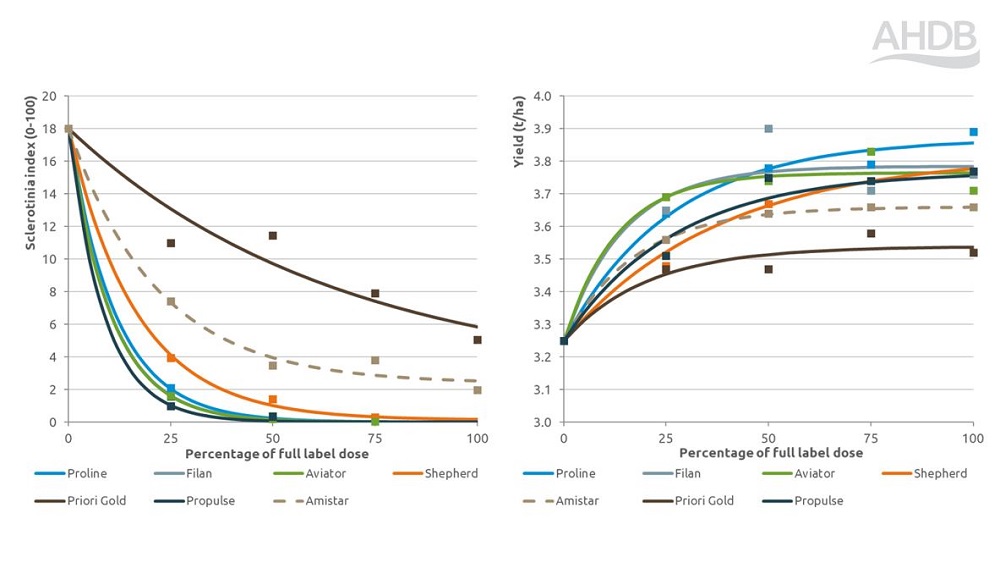- Home
- Knowledge library
- Fungicide performance dose-response curves for winter oilseed rape
Fungicide performance dose-response curves for winter oilseed rape
Our fungicide performance trials provide independent information on the relative efficacy of fungicides against phoma stem canker, light leaf spot and sclerotinia stem rot in winter oilseed rape. This page features the latest disease and yield dose-response curves.
Introduction
Data from our fungicide performance trials is used to plot dose-response curves. The charts show the average performance of fungicide products (disease and yield responses) across sites, seasons and leaf layers.
Curves that fit the data points well and have clear separation are most likely to reflect real differences (in terms of field performance).
To maximise differences between treatments, the trials use:
- High-disease-risk locations
- Highly susceptible varieties
- Two sprays for phoma stem canker and light leaf spot
- Single spray for sclerotinia stem rot
Products
It is not possible to test all products in fungicide performance trials. The products are carefully selected to:
- Provide the most relevant results
- Give equal opportunity for agrochemical companies to include products in trials
- Put emphasis on testing pre-registration or new active ingredients*
- Include standard products for which there is good understanding of performance (to aid comparisons)
*Only authorised plant protection products feature in the dose-response curves.
- Aviator 235 Xpro – bixafen + prothioconazole: an SDHI + DMI/azole
- Architect – mepiquat chloride + prohexadione-calcium + pyraclostrobin: a QoI
- Filan – boscalid: an SDHI
- Priori Gold – azoxystrobin and difenoconazole: A QoI + DMI
- Proline 275 – prothioconazole: a DMI/azole
- Plover – difenoconazole: an DMI/azole
- Propulse – prothioconazole + fluopyram: an SDHI + DMI/azole
- Shepherd – boscalid and pyraclostrobin: an SDHI + QoI
- Toledo* – tebuconazole a DMI/azole
*Based on limited data. Not all products were tested in all years. See the full fungicide performance data sets for information on products tested in specific years.
Check the HSE plant protection product database for authorisation status
Dose-response curves
A selection of the key charts (released on 9 December 2025) are shown below.
Phoma stem canker
Disease and yield response
 AHDB
AHDB
Light leaf spot
Disease and yield response
 AHDB
AHDB
Sclerotinia stem rot
Disease and yield response

Combined results for 2015–17 (5 trials). This disease is no longer a target for the fungicide performance project. Historic information is shown for reference.
Summary
Phoma stem canker
- Effective azole and non-azole options for phoma stem canker control
- Yield responses ranged from 0.15 to 0.50 t/ha in 2025
- There was little benefit from applying >50% full-label rate (as part of a two-spray programme)
Light leaf spot
- Azoles, non-azoles and co-formulations effective and provide a similar disease reduction
- Azoles, non-azoles and co-formulations provide similar uplift in yield
- Both azole and non-azole chemistry available for use in the autumn
- Timing of application important to achieve control and yield protection
Sclerotinia stem rot
- All modes of action available for sclerotinia control can now be used elsewhere in the fungicide programme
- Consider what active ingredients have been used previously within the fungicide programme and use alternation and mixtures for resistance management
All fungicide performance results
The full fungicide performance results cover all target diseases for wheat, barley and oilseed rape.
Most charts on this web page show the average performance of fungicide products over multiple seasons.
The full results also include single-year data.
The latest results are released in December at the annual AHDB Agronomy Conference. These are available, alongside the presentation slides and video, from the fungicide performance home page.
Further information
Latest reports for phoma and light leaf spot
A guide to fungicide performance
Guidance from the Fungicide Resistance Action Group (FRAG)
Phoma management in winter oilseed rape
Light leaf spot management in winter oilseed rape
Sclerotinia stem rot management in winter oilseed rape
Back to: Fungicide performance in cereals and oilseed rape home page

